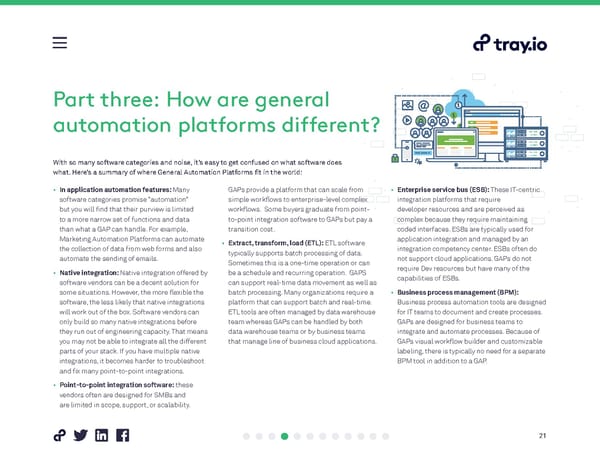Part three: How are general automation platforms different? With so many software categories and noise, it’s easy to get confused on what software does what. Here’s a summary of where General Automation Platforms fit in the world: • In application automation features: Many GAPs provide a platform that can scale from • Enterprise service bus (ESB): These IT-centric software categories promise “automation” simple workflows to enterprise-level complex integration platforms that require but you will find that their purview is limited workflows. Some buyers graduate from point- developer resources and are perceived as to a more narrow set of functions and data to-point integration software to GAPs but pay a complex because they require maintaining than what a GAP can handle. For example, transition cost. coded interfaces. ESBs are typically used for Marketing Automation Platforms can automate • Extract, transform, load (ETL): ETL software application integration and managed by an the collection of data from web forms and also typically supports batch processing of data. integration competency center. ESBs often do automate the sending of emails. Sometimes this is a one-time operation or can not support cloud applications. GAPs do not • Native integration: Native integration offered by be a schedule and recurring operation. GAPS require Dev resources but have many of the software vendors can be a decent solution for can support real-time data movement as well as capabilities of ESBs. some situations. However, the more flexible the batch processing. Many organizations require a • Business process management (BPM): software, the less likely that native integrations platform that can support batch and real-time. Business process automation tools are designed will work out of the box. Software vendors can ETL tools are often managed by data warehouse for IT teams to document and create processes. only build so many native integrations before team whereas GAPs can be handled by both GAPs are designed for business teams to they run out of engineering capacity. That means data warehouse teams or by business teams integrate and automate processes. Because of you may not be able to integrate all the different that manage line of business cloud applications. GAPs visual workflow builder and customizable parts of your stack. If you have multiple native labeling, there is typically no need for a separate integrations, it becomes harder to troubleshoot BPM tool in addition to a GAP. and fix many point-to-point integrations. • Point-to-point integration software: these vendors often are designed for SMBs and are limited in scope, support, or scalability. 21
 General Automation Platforms Page 20 Page 22
General Automation Platforms Page 20 Page 22